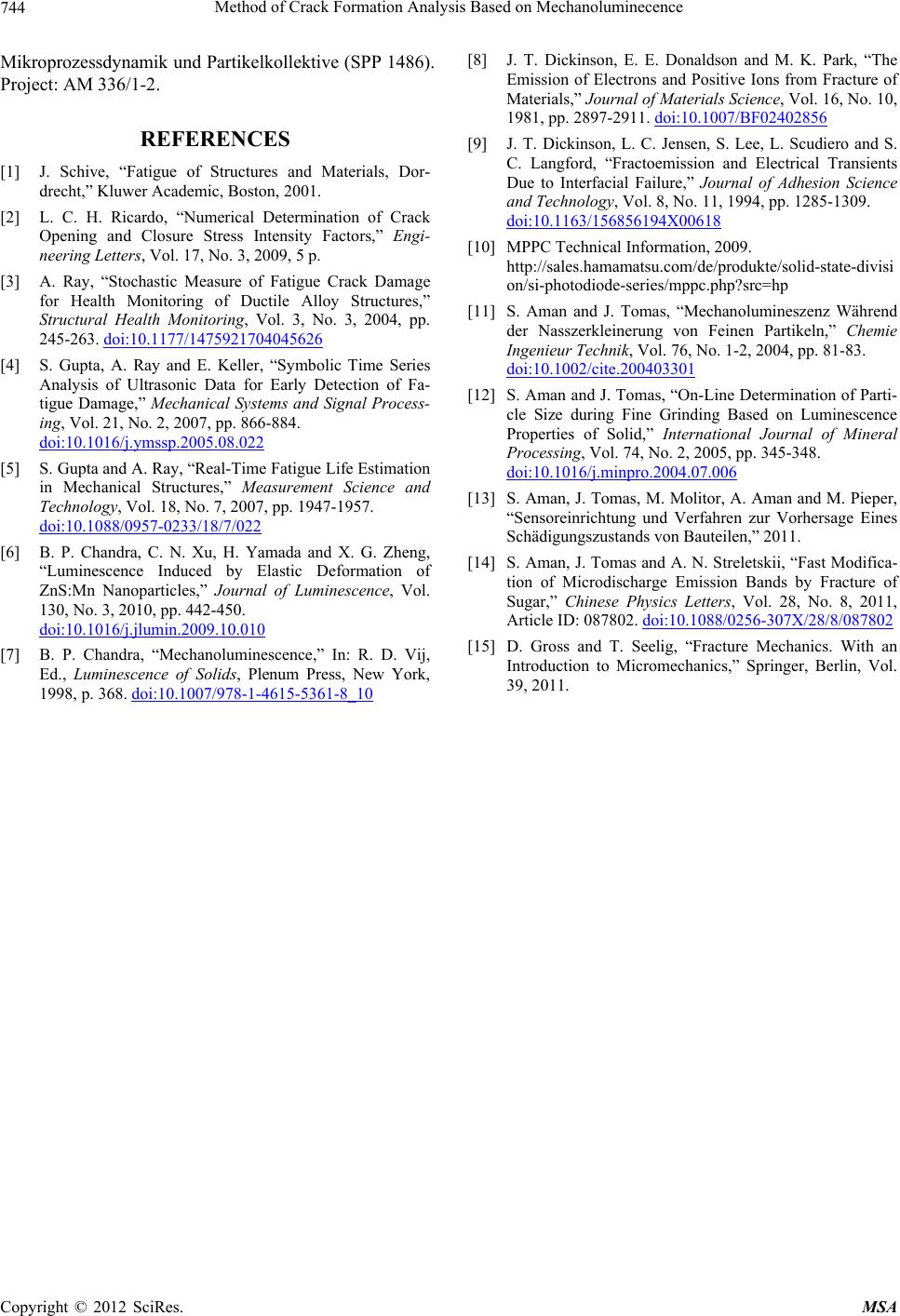
Method of Crack Formation Analysis Based on Mechanoluminecence
Copyright © 2012 SciRes. MSA
744
Mikroprozessdynamik und Partikelkollektive (SPP 1486).
Project: AM 336/1-2.
REFERENCES
[1] J. Schive, “Fatigue of Structures and Materials, Dor-
drecht,” Kluwer Academic, Boston, 2001.
[2] L. C. H. Ricardo, “Numerical Determination of Crack
Opening and Closure Stress Intensity Factors,” Engi-
neering Letters, Vol. 17, No. 3, 2009, 5 p.
[3] A. Ray, “Stochastic Measure of Fatigue Crack Damage
for Health Monitoring of Ductile Alloy Structures,”
Structural Health Monitoring, Vol. 3, No. 3, 2004, pp.
245-263. doi:10.1177/1475921704045626
[4] S. Gupta, A. Ray and E. Keller, “Symbolic Time Series
Analysis of Ultrasonic Data for Early Detection of Fa-
tigue Damage,” Mechanical Systems and Signal Process-
ing, Vol. 21, No. 2, 2007, pp. 866-884.
doi:10.1016/j.ymssp.2005.08.022
[5] S. Gupta and A. Ray, “Real-Time Fatigue Life Estimation
in Mechanical Structures,” Measurement Science and
Technology, Vol. 18, No. 7, 2007, pp. 1947-1957.
doi:10.1088/0957-0233/18/7/022
[6] B. P. Chandra, C. N. Xu, H. Yamada and X. G. Zheng,
“Luminescence Induced by Elastic Deformation of
ZnS:Mn Nanoparticles,” Journal of Luminescence, Vol.
130, No. 3, 2010, pp. 442-450.
doi:10.1016/j.jlumin.2009.10.010
[7] B. P. Chandra, “Mechanoluminescence,” In: R. D. Vij,
Ed., Luminescence of Solids, Plenum Press, New York,
1998, p. 368. doi:10.1007/978-1-4615-5361-8_10
[8] J. T. Dickinson, E. E. Donaldson and M. K. Park, “The
Emission of Electrons and Positive Ions from Fracture of
Materials,” Journal of Materials Science, Vol. 16, No. 10,
1981, pp. 2897-2911. doi:10.1007/BF02402856
[9] J. T. Dickinson, L. C. Jensen, S. Lee, L. Scudiero and S.
C. Langford, “Fractoemission and Electrical Transients
Due to Interfacial Failure,” Journal of Adhesion Science
and Technology, Vol. 8, No. 11, 1994, pp. 1285-1309.
doi:10.1163/156856194X00618
[10] MPPC Technical Information, 2009.
http://sales.hamamatsu.com/de/produkte/solid-state-divisi
on/si-photodiode-series/mppc.php?src=hp
[11] S. Aman and J. Tomas, “Mechanolumineszenz Während
der Nasszerkleinerung von Feinen Partikeln,” Chemie
Ingenieur Technik, Vol. 76, No. 1-2, 2004, pp. 81-83.
doi:10.1002/cite.200403301
[12] S. Aman and J. Tomas, “On-Line Determination of Parti-
cle Size during Fine Grinding Based on Luminescence
Properties of Solid,” International Journal of Mineral
Processing, Vol. 74, No. 2, 2005, pp. 345-348.
doi:10.1016/j.minpro.2004.07.006
[13] S. Aman, J. Tomas, M. Molitor, A. Aman and M. Pieper,
“Sensoreinrichtung und Verfahren zur Vorhersage Eines
Schädigungszustands von Bauteilen,” 2011.
[14] S. Aman, J. Tomas and A. N. Streletskii, “Fast Modifica-
tion of Microdischarge Emission Bands by Fracture of
Sugar,” Chinese Physics Letters, Vol. 28, No. 8, 2011,
Article ID: 087802. doi:10.1088/0256-307X/28/8/087802
[15] D. Gross and T. Seelig, “Fracture Mechanics. With an
Introduction to Micromechanics,” Springer, Berlin, Vol.
39, 2011.